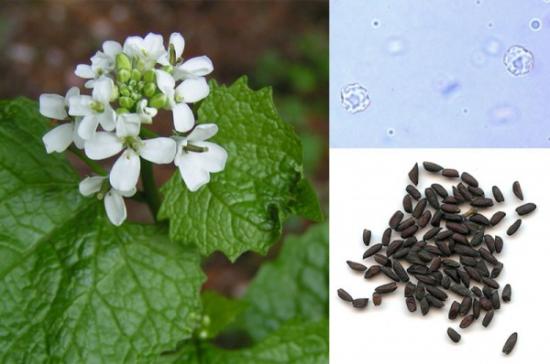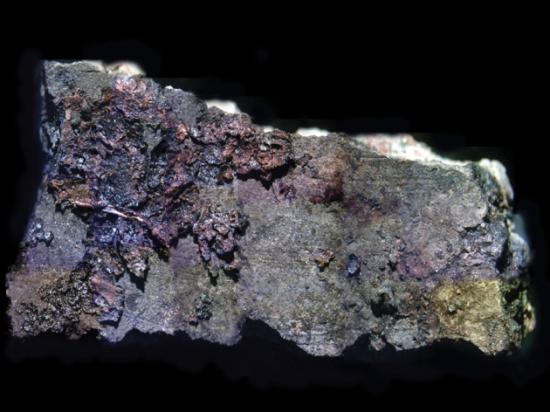Hunter-gatherers' taste for spice
University of York
Source - http://www.eurekalert.org/pub_releases/2013-08/uoy-rrh082113.php
Our early ancestors had a taste for spicy food, new research led by the University of York has revealed.
Archaeologists at York, working with colleagues in Denmark, Germany and Spain, have found evidence of the use of spices in cuisine at the transition to agriculture. The researchers discovered traces of garlic mustard on the charred remains of pottery dating back nearly 7,000 years.

(left) Sannse/Creative Commons; (top right): Saul et al., PLoS ONE (2013); (bottom right): Hardyplants/ Wikimedia Commons . Old spice. Discovery of tiny bits of plant-produced silica called phytoliths (upper right) from the seeds (right) of the garlic mustard plant (Alliaria petiolata, left) suggest that Stone Age cooks were using spices up to 6100 years ago.
The silicate remains of garlic mustard (Alliaria petiolata) along with animal and fish residues were discovered through microfossil analysis of carbonised food deposits from pots found at sites in Denmark and Germany. The pottery dated from the Mesolithic-Neolithic transition from hunter-gathering to agriculture.

Mineral fragments of plant origin caked onto ancient cooking vessels show that northern Europeans liked their food spicy six millennia ago. H. SAUL ET AL.
Previously scientists have analysed starches which survive well in carbonised and non-carbonised residues to test for the use of spices in prehistoric cooking. But the new research, which is reported in PLOS ONE, suggests that the recovery of phytoliths – silicate deposits from plants -- offers the additional possibility to identify leafy or woody seed material used as spices, not detectable using starch analysis. Phytoliths charred by cooking are more resilient to destruction.
Lead researcher Dr Hayley Saul, of the BioArCH research centre at at the University of York, said: "The traditional view is that early Neolithic and pre-Neolithic uses of plants, and the reasons for their cultivation, were primarily driven by energy requirements rather than flavour. As garlic mustard has a strong flavour but little nutritional value, and the phytoliths are found in pots with terrestrial and marine animal residues, our findings are the first direct evidence for the spicing of food in European prehistoric cuisine.

Early contexts from which spices have been recovered, with photomicrographs of globular sinuate phytoliths recovered from the pottery styles illustrated. Showing, A) A map of Europe showing an inset of the study area and sites from which the pot residues were acquired;, including also the Near East and northern Africa indicating early contexts where spices have been recovered: a) Menneville, France (Papaver somniferum L.), b) Eberdingen, Germany (Papaver somniferum L.), c) Seeberg, Switzerland (Papaver somniferum L.), d) Niederwil, Switzerland (Papaver somniferum L.), e) Swiss Lake Villages, Switzerland (Anethum graveolens L.), f) Cueva de los Murcielags, Spain (Papaver somniferum L.), g) Hacilar, Turkey (Capparis spinosa L.), h) Tell Abu Hureya, Syria (Caparis spinosa L.), i) Tell ed-Der, Syria (Coriandrum sativum L. and Cuminum cyminum L.), j) Khafaji, Iraq (Cruciferae family), k) Tell Aswad, Syria (Capparis spinosa L.), l) Nahal Hemar Cave, Israel (Coriandrum sativum L.), m) Tutankhamun's tomb, Egypt (Coriandrum sativum L.), n) Tomb of Kha, Egypt (Cuminum cyminum L.), o) Tomb of Amenophis II, Egypt (Anethum graveolens L.), p) Hala Sultan Tekke, Cyprus (Capparis spinosa L.), q) Heilbronn, Germany (Papaver somniferum L.), r) Zeslawice, Poland (Papaver somniferum L.) [compiled using 8–17]. B) Hunter-gatherer pointed-based vessel (on the left) and Early Neolithic flat-based vessel (on the right). C) Scanning Electron Microscope image of a globular sinuate phytolith embedded in a food residue, D) optical light microscope image of modern Alliaria petiolata globular sinuate phytoliths, and E) optical light microscope image of archaeological globular sinuate phytolith examples. doi:10.1371/journal.pone.0070583.g001
"Our evidence suggests a much greater antiquity to the spicing of foods in this region than is evident from the macrofossil record, and challenges the view that plants were exploited by hunter-gatherers and early agriculturalists solely for energy requirements, rather than taste."
###
The research was funded by the UK Arts and Humanities Research Council.
The research also involved scientists at the Institució Catalana de Recerca i Estudis Avançats, Institución Milá i Fontanals, Spanish National Research Council, Barcelona, Spain; the Danish Agency for Culture, Copenhagen, Denmark; the Institute of Prehistoric and Protohistoric Archaeology, University of Kiel, Kiel, Germany. And Stiftung Schleswig-Holsteinische Landesmuseen, Schloβ Gottorf, Schleswig, Germany.